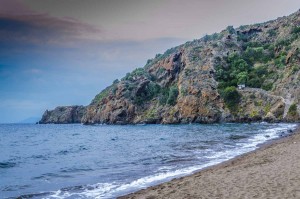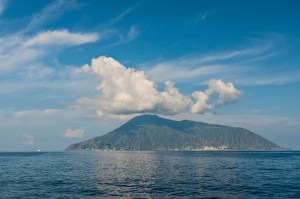
©Bigstock.com/MAEKFOTO
Volcanos are a big part of Italy, particularly of Sicily. It is home to what are likely the most active fiery craters of the entire continent granting the field of volcanology important insights into the geological processes connected to it. The Aeolian Islands in the Province of Messina with their two active volcanos play a key role in this context. They’ve been serving as important research and training grounds for over 200 years as they were created as the result of volcanic activities and even have two different kinds of eruptions named after individual islands. The seven islands – Lipari, Vulcano, Stromboli, Salina, Filicudi, Alicudi and Panarea – were declared UNESCO World Heritage Site in 2000 and invite you to go on amazing expeditions. In all reality, the Aeolian Islands indeed have more to offer than “just” volcanology.
About the Aeolian Islands
As mentioned before, the Aeolian Islands, which are also referred to as the Lipari Islands, are of volcanic origin. The extraordinary hang is at least partially responsible for this, as the edge of the African Plate presses against the Eurasian Plate. This collision caused the sea floor to partially rupture leading to magma eruptions. Due to its location in a subduction zone, the volcanic activities might not be overly explosive, yet remain pretty lively. This is due to the Apulian Plate taking a 90° degree turn from the African Plate here effectively changing its tectonic direction. It is now believed that the islands are fairly young and were formed in three phases. Filicudi was first, Panarea, Salina, Lipari and Alicudi followed later. Eventually, Vulcano and Stromboli came to be while Lipari gained its southernmost part of the island.

©Bigstock.com/byvalet
Excavations show that the Aeolian Islands were populated as early as the Neolithic and achieved a certain wealth as a provider of obsidian. Repeated destructions, settlements and pillages established a highly eventful history. There were attacks from Athens and Carthage, the first Christian church was founded on Lipari in the 3rd century, even pirates once populated the region. Tourism only hit the archipelago in the mid-20th century after out-migration had already heavily drained population numbers. “Stromboli”, a Roberto Rossellini movie from 1949, was partly responsible for bringing change. Tourism is now the main industry on the islands. You’ll even frequently find more tourists than actual residents in July and August.
Lipari
We start our round trip in Lipari, the largest and most important island – we call them “Lipari Islands” for a reason after all. The first thing you’ll probably notice is the 60-m-high rock with a 16th century castle. Inside the walls is the neat baroque church San Bartolomeo, which was built in 1654 after its medieval predecessor had been destroyed by Ottoman pirates. Some of the limestone capitals date back to the origins in the 11th and 12th century. The Archaeological Museum is also mostly located on the castle complex. Here you find gripping insights into the primeval settlement history and the region’s close connection to volcanology. Several quaint beaches invite you to enjoy a divine sunbath. By the way, walking through central Lipari in swimwear is forbidden and punished by a fine of 500 Euro.
Vulcano
According to Roman mythology, the smithy of Vulcano, god of fire, was on the island Vulcano. Its volcano’s unique eruption pattern – short, gunshot-like explosions with shock waves – even yielded the term “Vulcanian eruption” in volcanic research. The so-called “Dead Field” gained notoriety. Heat and toxic gasses after volcanic activities in the 1910s destroyed all plants. A bath in the groundwater mud pool, which can heat up to 52 °C due to the hot gasses, is said to bring medicinal benefits to those suffering from arthritis, rheumatism and various skin diseases.
Stromboli
Europe’s most active volcano rarely rests. While the last big volcanic event was over a decade ago, continuous eruptions are part of Stromboli’s everyday life – the phenomenon of constant eruption patterns with mild bursts is known as the “Strombolian eruption”. It was the movie “Stromboli” with Ingrid Bergman that turned the island into a popular tourist destination after 1949. You can even climb the volcanic cone with a local mountain guide or watch the spectacular eruptions at the observatory near Punta Labronzo, which is particularly awe-inspiring when it gets dark. If you’re lucky, you might even see Sciara del Fuoco, the lava stream flowing into the sea. Looking for a more serene type of holiday? Visit the small port village San Vincenzo with its characteristic white houses or hike to the old lighthouse.
Salina
The twin volcanos Monte dei Porri (860 m) and Monte Fossa delle Felci (962 m) left a decisive mark on Salina. It is the only island of the archipelago with a fresh-water spring giving it lush vegetation. Monte Fossa is covered in stunning forests that drop down almost vertically to the equally amazing beaches. Salina produces the divinely sweet white wine Malvasia delle Lipari and, together with the Sicilian island Pantelleria, covers 95% of all Italian caper harvesting. Don’t miss out on visiting the pilgrimage church Madonna del Terzito, which was built on the foundations of an ancient Roman temple, or the location of the multi-award-winning Radford film “The Postman”.
Filicudi and Alicudi
These two small islands in the western part of the archipelago mostly consist of inactive volcanic craters. You will be enchanted by the wonderful scenery with wild nature and scenic sea floors. Filicudi particularly lends itself to snorkelling and diving, even sailboarding in autumn. Familiarise yourself with the wildlife during botanical hikes and birdwatching. The rock cliffs in the northwest are the home of extreme climbers from all around the world. Alicudi doesn’t even have a road network. Century-old stepped paths connect the houses with one another. A brief walk through the inhabited east part of the island fascinates with a rustic atmosphere of yesteryear.
Panarea
Finally, we visit the smallest and lowest-rising island (the tallest “mountain” tops out at 421 m). Gentle underwater eruptions attract many tourists to Panarea and its adjacent islands. History becomes palpable here – the excavations of a villa on the Capo Milazzese or the ruins of a Roman villa with an underwater pier and thermal bath on the Isola di Basiluzzo grant deep insights into the region’s illustrious settlement history. Panarea’s most beautiful beach is at Cala di Junco in the southeast. The three villages on the east coast, San Pietro, Ditella and Drauto, almost blend together.
The Lipari or Aeolian Islands are a genuine treasure chest. You’ll probably be most interested in their fascinating volcanic activities and their geological as well as topographic phenomena. However, there are countless other amazing options to experience the diverse nature of the archipelago, its unique settlement history and, without a doubt, the awesome beaches waiting for you. Time to board the next ferry!